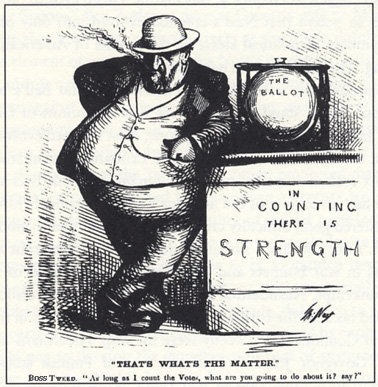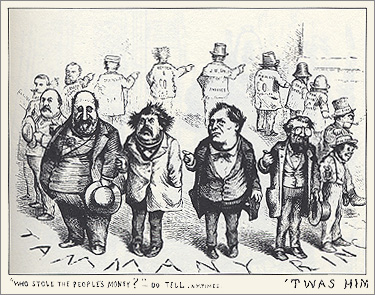| |
Anyone familiar with American
history will doubtlessly recall the downfall and eventual imprisonment
of Boss Tweed at the hands of political cartoonist Thomas Nast.
Tweed was part of the Tammany
Hall Ring which dominated New York City politics in the late
19th century. Tammany Hall operated on the principles of
cronyism and division of spoils. It was a great time for
crooks. More than 200 million dollars were estimated to
have been stolen through the Ring's graft and insider deals.
Against this baldly exercised
political power, Nast's cartoons were no gentle rebuke. In
one, he portrays Tweed as saying "As long as I count the
Votes, what are you going to do about it? Say?" It
puts many in mind of the Florida vote count of 2000, perhaps
unfairly (let history judge).

In another cartoon, he portrays
the members of the Tammany Hall Ring arranged in a circle. When
asked the question: "Who stole the people's money?"
each pouting politician points to the person on his right.
|
|

President Truman would have had
nothing of such pettifoggery. He was proud to say, "The
buck stops here."
All too often, the current occupant
of The White House seems to say, "The buck stops where? Not
here. Somebody else did it. The President needs a nap."
Thomas Nast would have had a
field day; and in his day, his voice was heard.
. . . [T]he undoing of boss Tweed
by Thomas Nast stands as a 'defining moment'--perhaps the defining
moment--in the history of American political cartooning. According
to Thomas C. Leonard, it marked no less than the genesis of 'visual
thinking about political power' in American journalism. Fischer,
Roger A. Them Damned Pictures. North Haven, Connecticut:
Archon Books. 1996. p. 7.
The year 2004 may prove to be
another watershed year; and If King George II is dethroned in
2004, it will in no small part be the work of a contemporary
political cartoonist, known to his fans and admirers as simply
"The Wizard of Whimsy." |



